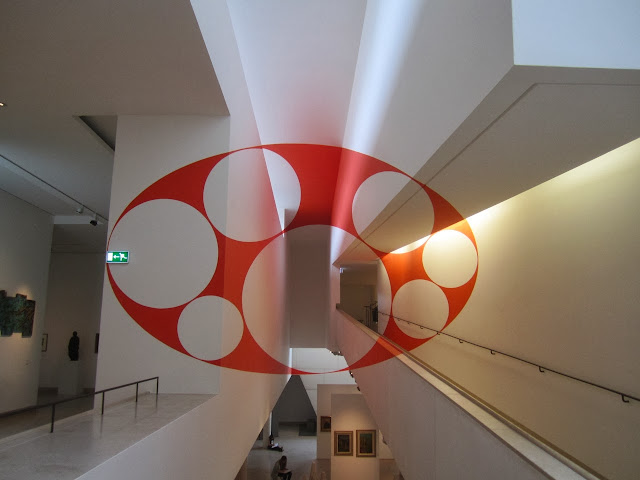27 October 2013
Part 2 of the Nancy Trilogy
In the center of Nancy, on one side of the Place Stanislas, is the Musée des Beaux-arts. Many French towns have art museums because, in the decades after the Revolution, the art confiscated by the government was slowly “repatriated” into art museums. This tradition has continued following certain World’s Fairs and Universal Expositions. Of course, at the same time, local residents have given their collections to the local museums and the museums have gone on buying sprees. In some towns these museums end up a bit lacking (cough Chalons) while other towns luck out and amass very impressive collections of fine art. Luckily this was the case with the Nancy museum, which had a collection that covered everything from primitives to Picasso. The collection is well lit, varied, and I spent at least two very enjoyable hours there.
The museum is centered around the 18th century building that fronts on the Place Stanislas though a very sizable portion of the museum is housed in a modern building that is almost completely hidden from the beautiful Place Stanislas. (Credit really should be given to the architect and museum board behind this action. First of all, to the modern architect who was finally forced to accept a second rate seat behind first rate 18th century architecture and to the museum board who undoubtedly kept the architect in his place.) I will say, however, that this modern space is wonderful and offers great lighting and lots of space for art.
One final thing that makes the Musée des Beaux-arts de Nancy especially neat (and that makes it a cousin to the Louvre in Paris) is that when they were digging the foundations for the new addition, they came across the Medieval city wall… and they kept it… And highlight it. The same thing happened to the Louvre when they were doing their renovation and construction the IM Pei Pyramid in the 1980s. In my opinion, the incorporation of the wall makes a fascinating addition to the museum and provides a sense of the fortifications of European cities of the time period. What I really liked with the city walls at Nancy was the artwork that was displayed in those areas: it was the collection of the Daum glassworks. Why do I find that cool? Well on one side of the exhibition space you have this massive stone wall, with giant blocks and, in some places, centuries-old inscriptions, perhaps left by the men who were assigned to carve the blocks. On the other side: dozens of glass cases full of the most feminine, curvilinear Art Nouveau glass imaginable. It was just a really beautiful juxtaposition and such an amazing space to visit.
And now, for some highlights:
Students in the architectural drawing class take advantage of the beautiful lobby.
The spiral staircase the brings visitors to the upper galleries.
.
L’Enlèvement d’Hélène, 1530-31, Mathis Gerung
Even though there’s an entire history behind this painting that involves the Trojan War, I really like it because of the whimsical temple of love at the center of the painting. That would be a great building to have in one’s backyard.
Virgin with Child, 1650, Charles Le Brun
Le Brun was the decorator of a few important buildings in France, including Versailles.
Just to give an idea of some of the rooms and the size of the paintings, get a look at this! The large painting at the right is The Transfiguration by Peter Paul Rubens, 1604-5.
Aurore et Céphale, 1733, by François Boucher, painted for a Parisian lawyer
Who doesn’t love some libertine loving from time to time?
Anne and Jehanne, circa 1894 by Laura Leroux-Revault
detail
Gustave Doré, Mountain Landscape, circa 1870
Is this the French version of the Hudson River School that made Mount Desert Island so famous?
For comparison I present Frederic Edwin Church’s painting, Sunset, from 1856, now in the collection of the Williams-Proctor Institute Museum of Art in Utica.
A bit of Picasso, of course. Man and Woman, 1971
I think this may have been my favorite painting in the entire museum. It is called “La Toussaint” and was painted by Émile Friant in 1888. It was an award winner in the Salon of 1889 and was purchased by the State. The scene depicts a family entering one of the cemeteries in Nancy on the day of Toussaint (All Saint’s Day) the artist actually captured the details in a way that is almost photographic and amazing.
Another Friant was this one: Les Jours heureux (Happy Days) of 1895. It made me think of the Sound of Music.
detail
This was a piece of art that I really didn’t understand at first. When I first saw it from this view I thought it was just orange blobs on the wall and didn’t give it much consideration other than to think: Oh, that’s orange, I like orange.
Then I got to the next level down and looked at it and it was this:
It’s called “Ellipse orange évidée par sept disques” by Felice Varini in 2000. It’s a type of art that I didn’t even realize had a real name: Architectural art, but that I find super cool because of all the different ways it can appear depending on the location of the viewer.
The museum also had a fairly sizable collection of the work of artist/architect/designer Jean Prouvé.
This is a model of a proposal by Prouvé for a circular hotel and it reminds me a great deal of a Buckminster Fuller’s Dymaxion House.
Here are three of his chairs dating from 1929-1932.
And of course, a little glance at some of the Daum glass in the basement.
The piece on the left dates to 1925.
These are all 1890s pieces
Modern work, 1989





















No comments:
Post a Comment